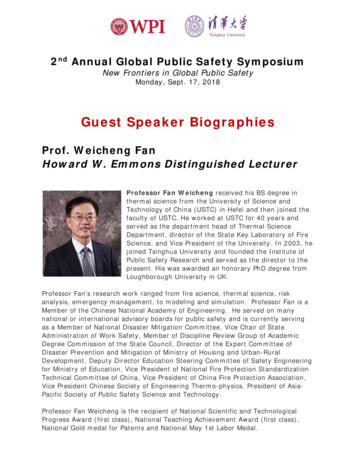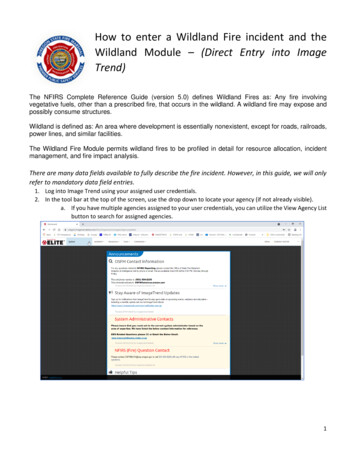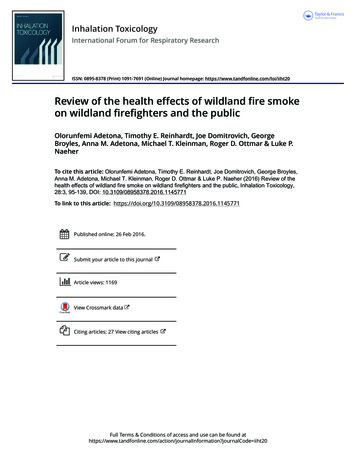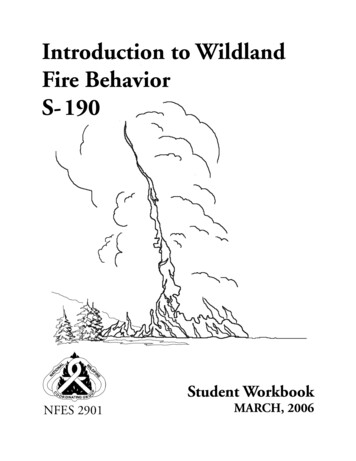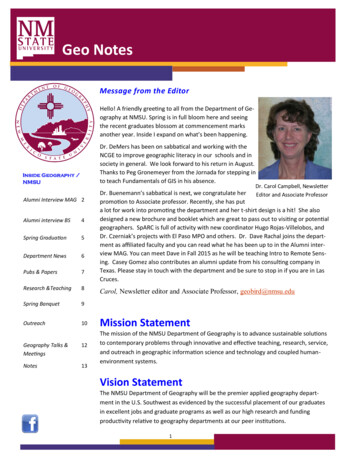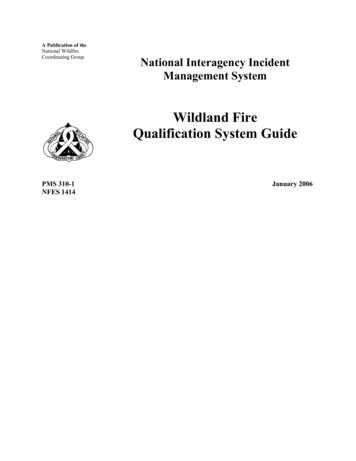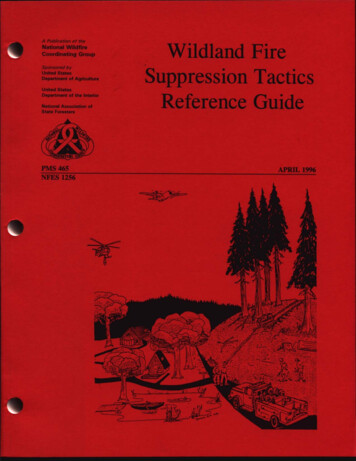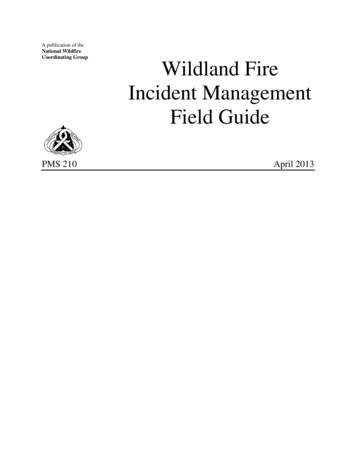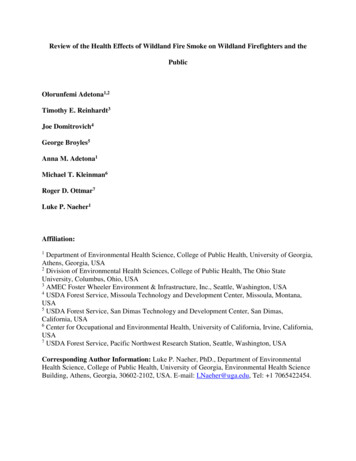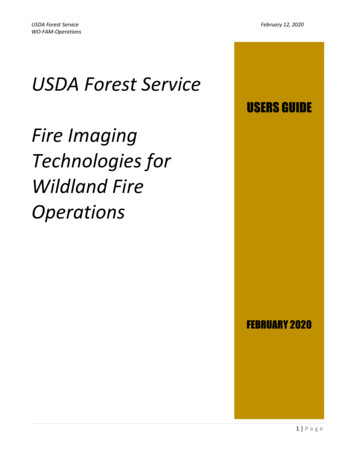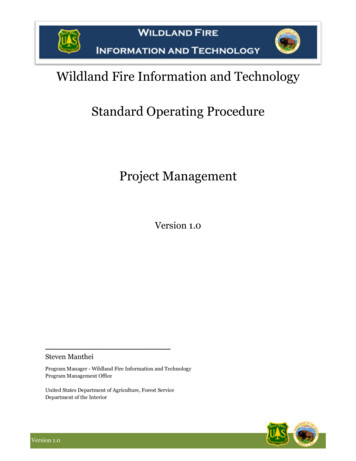
Transcription
Wildland Fire Information and TechnologyStandard Operating ProcedureProject ManagementVersion 1.0Steven MantheiProgram Manager - Wildland Fire Information and TechnologyProgram Management OfficeUnited States Department of Agriculture, Forest ServiceDepartment of the InteriorVersion 1.0
Wildland Fire Information and TechnologyThis page left intentionally blankPage 1 of 44
Wildland Fire Information and TechnologyTable of Contents1. Objectives of the Project Management Standard Operating Procedure .42. PLC Leadership – Decision Bodies and Working Groups.53. Assets managed via the WFIT Project Management SOP .74. Alignment of Investment Activities with Fiscal Definitions .85. The WFIT Project Management Life Cycle .105.1.Idea Phase.145.2.Concept Phase .175.3.Pre-development Phase .215.4.Development Phase.255.5.Project Management Status Reviews.315.6.Operations and Maintenance Phase .325.7.Decommission Phase.356. WFIT Project Life Cycle Summary Definitions .387. RASCI Chart Roles.408. Definitions .429. Revision history .44Table of FiguresFigure 1 - Project Management – WFIT Decision Bodies .5Figure 2 - WFIT Activity RASCI Chart – Execution .6Figure 3 -WFIT Project Life Cycle Summary .10Figure 4 - Components of the PLC .11Figure 5 - Flow of an Asset through the PLC.12Figure 6 - Components of the WFIT Project Life Cycle .38Version 1.0Page 2 of 44
Wildland Fire Information and TechnologyThis page left intentionally blankPage 3 of 44
Wildland Fire Information and Technology1. Objectives of the Project Management Standard Operating ProcedureThe objectives of the WFIT Project Management Standard Operating Procedure (PMSOP) are:1) Identify a standard WFIT project life cycle (PLC) by which an asset within the WFIT Portfolio canbe effectively managed by WFIT Leadership during its development and operational life;2) To establish a standard and consistent process of information compilation and decision makingto competently advance investments through the PLC;3) To establish a decision making cadence to advance projects through the lifecycle;4) To establish expected information for each life cycle checkpoint.The PMSOP seeks to identify the information necessary to make competent investment managementdecisions by the appropriate decision makers to maximize the effectiveness of WFIT investmentactivities as identified by WFIT Leadership using the Investment Decision Standard Operating Procedure(ID SOP).Version 1.0Page 4 of 44
Wildland Fire Information and Technology2. PLC Leadership – Decision Bodies and Working GroupsThe management structure responsible for WFIT project management considers oversight andinformation collection / management of both development activities (Development, Modernization, andEnhancement or DME) and steady-state activities (Operations and Maintenance, or O&M). The PMSOPis designed to provide those responsible for oversight with the comprehensive information necessary tomake competent decisions, and to provide those responsible for information collection andmanagement, well-defined expectations.This SOP identifies decision bodies as those responsible to approve the transition of an asset throughthe PLC. WFIT decision bodies are also noted in the IDSOP as they have been formed to identify, select,and manage of wildland fire investment activities. They are noted Figure 1 - Project Management –WFIT Decision Bodies as groups A through F. Each group’s role and responsibility with respect to thePLC are identified in the PMSOP to ensure their mission, objectives, and strategies are appropriatelyconsidered during investment activities, and are aligned with their roles in the IDSOP.This SOP identifies working groups to manage the information presented in the PLC processes. Thesegroups are identified Figure 1 - Project Management – WFIT Decision Bodies as groups 1 through 4.They are comprised of subject matter experts (SMEs) aligned with the phases they support within thePMSOP (e.g. Project Management Group is comprised of certified project managers, the PlanningWorking Group is comprised of those individuals well versed in technical planning and agency financialplanning processes). The roles and responsibilities of these groups, with respect to the PLC, are detailedin this document.Figure 1 - Project Management – WFIT Decision BodiesPage 5 of 44
Wildland Fire Information and TechnologyThis SOP identifies agency decision bodies whose roles are established to meet agency policy (primarilybudget, acquisition, and security). Their roles are defined by their respective agency’s objectives andresponsibilities. WFIT investment decisions and the processes identified in this SOP are intended toalign with their agency’s policies, expectations, and processes;Finally, the wildfire community is comprised of many stakeholders. This SOP identifies informedstakeholders who depend on information regarding the WFIT investments, and at times must beconsulted to ensure a comprehensive understanding of the community’s needs;Each oversight body’s objective is identified in the IDSOP, and their primary oversight responsibility withrespect to the PLC is identified in detail in this document. For each deliverable, parties are identifiedwho are involved with the completion of the delivery, or notified of its results. These are noted with theWFIT Activity RASCI Chart, shown in Figure 2 - WFIT Project Activity RASCI Chart and within thisdocument, below. The RASCI chart identifies roles that impact PLC activities:1. Responsible: those responsible to complete the defined task – executes the necessary work2. Accountable: those ultimately answerable for the completion of the task3. Supportive: assists in completing the task4. Consulted: opinions are sought (SMEs), or5. Informed: kept up to date; one way communicationThis chart is aligned with activities identified within the WFIT PLC, and is maintained by the WFIT PMO.Roles noted in the RASCI Chart are briefly defined in Section 7 - RASCI Chart Roles.IdeaWFIT Activity RASCI ry Business Value AssessmentIIRAIIIIICIIIIRACCCIPass Idea GateIACIIIRRIIIIAIISIIAISIIInitial Business RequirementsICISIIARIIIIRSCCCRCCCCSSIIIIInitial Business ValueICISIIARISSIIIITechnology AssessmentIICSIIASRIRIIIIDISAA AssessmentIICSIIAIRISServices AssessmentIICSCCACRCCProof of ConceptIICSIIASRCSIISIICCCIPrelim. Project Resource RequirementsICCACRIICSIIASRIIPass Concept GateIACSIIRSSCSProvide Funding for Pre-Development PhaseIRIIIIASCEstablish Pre-Development Project TeamIIACRISCCIIBusiness IDISAA RequirementsSCSICARCService RequirementsIICCSCACRCProject Documents (Schedule, Resources, IIIIIIIIAIIIARSSSSSSRIIEstablish Development TeamIIARISSSUpdate Project DocumentationCCSIARRRequirements etIBusiness CaseCAcquisitionsICTechnology RequirementsICCIISIIdentify Funding Req'd for Pre-Dev. PhaseCCIIdentify Funding Required for Concept PhaseCField /UsersNon-Federal andTribalDOI FireDirectorsFireExecutive CouncilOWFFAMPRESSIIAcquisition ManagementIICACSIISCARRTracking ReportingIIIIIIARRIIIIProject Management ReviewsICIARSSSIISSO&M Plan DevelopmentCICSCASRProject DeliverablesICCCIARRCCIDevelopment ActivitiesPass Development Gate (User Acceptance)IIIACCPass Development Gate (ATO)AAIIIRSRSSCIIIIIRSSIIITransition to O&M OrganizationIIARSIIIIIApplication OperationsIIIARSSICapability Change ManagementICCARCCCStatus ReportingIIIIARSSIDecommission PlanICCCARSSCCCACIIIAIIAIPass O&M GateVersion 1.0StatePrivate ForestrySSICUpdate 5 Year PlanDecommissionEmergingTechnologies GroupSSIIIRB Approval Funding Status GateOperations and MaintenanceNWCGRRIIPass Pre-Development GateDevelopmentTechnicalLeadICIFeasibility AssessmentEstablish Concept Project TeamExecutionBusinessLeadAABusiness Need / IntentProvide Funding for Concept PhaseConceptProjectManagerIIO&MWorking GroupCCDevelopmentWorking GroupCCPlanningWorking GroupCCProgramBoardActivitiesDISAA StandardsServices Stds. (Training, Helpdesk, Hosting, etc.)FMBCategoriesCommon ProjectComponentsWFIT ProgramManagerWFITEBDOIACIOsUSFSCIORASCIR Responsible for completing the task or deliveryA Accountable to ensure task or delivery is is completedS Supportinve to those responsibleC Consulted for inputs to those responsibleI Informed of task / delivery resultsDOI/USDACIOsA Two AccountablesRevUSDA / DOIIRBsFigure 2 - WFIT Project Activity RASCI Chart – ExecutionImplement Decommission PlanDecommission NotificationIIIIIIRIICSRSSIIRIIIPage 6 of 44SIRIICIIII
Wildland Fire Information and Technology3. Assets managed via the WFIT Project Management SOPThe WFIT Portfolio (Portfolio) is comprised of assets developed to provide capabilities to wildland fireoperations and delivered via information and technology components. An asset may be a softwareapplication that collects, analyzes, or reports information, it may be the infrastructure used to supportthe software application, or it may be a supporting service (e.g. helpdesk support, training tools, datamanagement). WFIT Leadership manages the Portfolio to deliver assets in the most effective andefficient manner, in alignment with agency policies, and supporting the cross-agency mission andobjectives of wildland fire community.Per the WFIT Portfolio Management Standard Operating Procedure (PtMSOP), assets within thePortfolio are organized into three tiers. They are:Tier 1 – those assets that are funded and managed by WFIT Leadership whose capabilities aredeveloped specifically for the betterment of wildland fire operations (e.g. WFDSS, FEPMIS, ROSS);Tier 2 – those assets that funded by WFIT allocated funds but whose capabilities are prescribed bythe owner (e.g. NOAA subscriptions, FlamMap); andTier 3 – those assets whose capabilities are relied upon by the wildland fire community but notprescribed, or funded, by WFIT (e.g. VIPER, ).The PMSOP primarily considers Tier 1 assets. These assets considered as they involve manageddevelopment activities, providing both schedule and resource oversight, as well as ensuring the resultingasset delivers the expected capability, as prescribed via the Investment Decision Standard OperatingProcedure (IDSOP).Tier 2 and Tier 3 assets are used by the wildland fire community and share information with Tier 1assets, and so their impact must be understood and considered during the development and operationof Tier 1 assets.The PMSOP organizes the development, compilation, presentation and oversight of pertinentinformation associated with asset development and steady state operations, as appropriate.Page 7 of 44
Wildland Fire Information and Technology4. Alignment of Investment Activities with Fiscal DefinitionsThe insertion of an investment activity into the PLC is at the discretion of the FMB with support andoversight by the PB and PMO. Appropriate considerations and recommendations must be made by theoversight groups to ensure that all agency and department expectations are considered to ensure thatinvestment activities are monitored and reported under the proper OMB classifications.To support informed investment decisions, the categorization of investments between development andoperations is valuable. These categories are generally defined in the Office of Management and Budget(OMB) as Development, Modernization and Enhancement (DME) and Operations and Maintenance(O&M), respectively.OM ’s FY 14 Ex; 300 guidance document refers to DME costs as:a) Activities leading to new IT assets/systems, andb) Activities that change or modify existing IT assets to: substantively modify or improve capabilityor performance, implement legislative or regulatory requirements, or meet an agency leadershiprequest. Costs can include hardware, software development and acquisition costs, commercialoff-the-shelf acquisition costs, government labor costs, and contracted labor costs for planning,development, acquisition, system integration, and direct project management and overheadsupport.OM ’s FY 14 Ex; 300 guidance document refers to O&M activities as:a) Operations - the phase of the life cycle in which the asset is in operations and produces thesame product or provides a repetitive service, andb) Maintenance - an investment activity necessary to keep an asset functioning as designedduring the O&M phase of an investment. Some maintenance activities should be managedas projects and reported in Section B of Exhibit 300B. Examples of maintenance projectsmay include: operating system upgrades, technology refreshes, and security patchimplementations.The Federal Accounting Standards Advisory Board (FASAB) Statement of Federal Financial AccountingStandards Number 10 identifies:a) Maintenance costs as all costs (including all related personnel costs) needed to sustain an ITasset at the current capability and performance levels, and specifically excluding activitiesaimed at expanding the capacity of an asset, or otherwise upgrading it to serve needs differentfrom or significantly greater than those originally intended;”b) Technology refreshment costs are those costs associated with the intentional, incrementalinsertion of new technology (hardware or software), targeted at increasing capability, improvingreliability, maintainability, efficiency, or performance.Version 1.0Page 8 of 44
Wildland Fire Information and TechnologyThis SOP, identifies two categories aligned with OM ’s and F!S! guidance, and aligned with the PLCdescribed in the ProjSOP. They are: DMEaligned with OM ’s DME categoryaligned with F!S! ’s technology refreshment category,includes investment activities within the Idea, Concept, and Pre-development phases of the PLCincludes investment activities that modify any implementation, or use of, DISAA componentsFrom DOI Budget SheetDevelopment (Contract)Development Partner (Contract)Software PurchaseHardware PurchaseData UpdatesData Improvements O&Maligned with OM ’s O&M category,aligned with F!S! ’s Maintenance categoryincludes any investment activity within the O&M and Decommissioning phases of the PLCEnd User TrainingFrom DOI Budget SheetOperations & Support OverheadHosting (Gov’t)Hosting (Contract)EquipmentSoftware LicensingHardware Licensing/MaintenanceContract Support PersonnelHelp Desk Services (Gov’t)Help Desk Services (Contract)Application TrainingAcquisition SupportSecurity Services (Contract)Security Services (Gov't)Application Maintenance (Contract)Application Maintenance (Gov't)Data managementApplication Funded Employee Travel/TrainingPage 9 of 44
Wildland Fire Information and Technology5. The WFIT Project Management Life CycleThe PLC is modeled after business standard stage-gate life cycle processes. The PLC intends to followthe standards established by the (insert Government project management standard) adapted toconsider the cross-agency character of WFIT.The PLC organizes the management of assets within the Portfolio to:1)2)3)4)5)6)Ensure new assets deliver the desired capabilities as identified via the IDSOP;Ensure asset implementation supports the objectives of WFIT technology strategies;Ensure asset implementations meet the policy of its stakeholder organizations,Manage the delivery of assets within budgeted scope, schedule and resource expectations;Ensure investment processes meet budgetary policy of its stakeholder organizations;Ensure that existing assets continue to meet the needs of the wildland fire community in themost effective and efficient manner; and7) Communicate development status of an asset.The PLC is summarized in the diagram depicted in Figure 3 as a standard stage-gate, phased approach toproduct development. The components within the summary diagram are depicted in Figure 4, definedin Section 6 of this document, and described in detail in this SOP by phase.Figure 3 -WFIT Project Life Cycle SummaryVersion 1.0Page 10 of 44
Wildland Fire Information and TechnologyFigure 4 - Components of the PLCAn asset enters into the PLC governance through two mechanisms. First, an idea may initially beconsidered by WFIT by engaging the ETG to being formulating the idea into an asset that meets abusiness need of the wildland fire community. This process can be initiated by any individual, or group,with interest in wildland fire activities. Second, an asset whose capabilities have developed a level ofinterest to the wildfire community, via interest by the FMB, may be injected into the PLC by the FMBwithin the Concept Phase to evaluate the enterprise impact of the asset.An asset moves through the PLC by meeting the exit criteria established at each stage-gate, as evaluatedby the oversight body. Any asset under the purview of WFIT, i.e. within the WFIT Portfolio, will continuethrough the PLC until it is decommissioned and no longer under the purview of WFIT. This cycle isdepicted in Figure 5 - Flow of an Asset through the PLC.The phase to which an asset is assigned is dependent on its level of development. At times it may occurthat an asset’s development status is impacted by development decisions, policy changes, and changesin business need and development objectives. At that time, the asset may move back in phase toaccurately reflect its development status and ensure proper oversight of accomplished developments,per the objectives of the PLC.Page 11 of 44
Wildland Fire Information and TechnologyFigure 5 - Flow of an Asset through the PLCVersion 1.0Page 12 of 44
Wildland Fire Information and TechnologyThis page left intentionally blankPage 13 of 44
Wildland Fire Information and Technology5.1. Idea PhaseAssets in this phase introduce ideas providing a new capability to the wildland fire community, dueeither to an identified unmet need, or implementing an improved capability by capitalizing on newtechnology.Objectives Version 1.0Articulate the business need, feasibility, business value to wildland fire.Engage the ETG to provide supportPage 14 of 44
Wildland Fire Information and TechnologyDeveloped Information/Activities1. Business Need / IntentClarify idea’s ability to meet a business need of the community with respect to WFIT priorities.Identify key deliverables and how they affect business needs. Creates first pass metric of eachdelivery to clarify the deliveries CGETGnoneField / UsersInformed – PMO, FMB, PB, PWG, DWG, OMWG, FAM, OWF, DOI Fire Directors,Non-Federal and Tribal entities2. Feasibility AssessmentReview technical and implementation feasibility of the formed – PMO, FMB, PB, PWG, DWG, OMWGConsultedPB3. Preliminary Business Value AssessmentEstablish a preliminary estimate of business value of the asset, considering the asset’s ability todeliver to the needs of the wildland fire business community and estimated development costs.During the Idea Phase, this needs only be a very preliminary estimate of GETGnoneFMBInformed – PMO, PB, PWG, DWG, OMWG, FAM, OWF, DOI Fire Directors, Non-FederalTribal Entities4. Identify Funding Required for Concept PhaseIdentify funding sources and levels required during Concept nsultedFMB, FAM,OWF,DOI FireDirectorsInformed – PMO, PB, PWG, DWG, OMWG, Non-Federal and Tribal entities5. Pass Idea GateEstablish and organize a review of the project by the FMB and NWCG to review the developedinformation compiled during the Idea ,NWCGFMBnonePBInformed – PMO, PB, PWG, DWG, OMWG, FAM, OWF, DOI Fire Directors, Non-Federaland Tribal entitiesPage 15 of 44
Wildland Fire Information and TechnologyFacilitating GroupETG Support development activities targeted at proving the idea through available tools andcollaboration opportunities. Minimize duplicity by considering existing capabilities and capabilities in development Maximize the idea’s value to Wildland Fire’s business priorities Recognizing current WFIT enterprise infrastructure and resources Recognize the requirements of WFIT foundational elements (DISAA) Recognize the requirements of WFIT service elements (training, deployment, help desk, datamanagement)Oversight BodiesFMB Evaluates new asset’s value to the wildland fire community and the ability to provide resourcesto the development efforts, in line with WFIT priorities.NWCG Evaluate the ability of the asset to meet the business needs of the Wildland fire community.Exit Criteria - Idea to Concept Checkpoint TemplateVersion 1.0Page 16 of 44
Wildland Fire Information and Technology5.2. Concept PhaseThe Concept Phase is intended to further establish, and communicate, the business requirementsthe asset intends to deliver, associated costs, and business value. Investigations are executed toestablish proof of concept, identify technology approaches, evaluate alignment with WFITtechnology strategies, identify risk areas, and potential risk mitigation strategies. Resources andcosts, and sourcing, necessary for pre-development phase activities are identified.Objectives Solidifies business value with success measuresValidate technology concepts, areas of concern and evaluate risksIdentify technology requirements alignment with WFIT Foundational elements (DISAA)Estimate development expenditure requirementsIdentify funding sourceIdentify Pre-development phase teamIdentify risks and potential mitigationsPage 17 of 44
Wildland Fire Information and TechnologyDeveloped Information/Activities – Prerequisite Activities1. Provide Funding for Concept PhaseAcquire funding as identified during Idea Phase from supporting tedPMFMBPWG, ETGFAM, OWF,DOI FireDirectorsInformed – Informed: PMO, PB, DWG, OMWG, NWCG2. Establish Concept Project TeamIdentify the Project Manager, Business Lead, and Technical Lead for Concept Phase edETGFMBPWG, NWCGFAM, OWF,DOI FireDirectors,Non-Federaland TribalEntitiesInformed – EB, PMO, PB, DWG, OMWGDeveloped Information/Activities1. Initial Business RequirementsIdentify the business requirements delivered by the asset and their alignment with eConsultedPWG, NWCG,FMBETG,Informed – PMO, PB, DWG, OMWG, TL, FAM, OWF, DOI Fire Directors,Non-Federal and Tribal entities2. Initial Business ValueEstablish a measure of business value of the asset, considering the asset’s ability to deliver tothe needs of the wildland fire business community and estimated development costs. Duringthe Concept Phase, this needs only be a first order of cost areas and rough estimates of sultedPWG, NWCG,FMBETG,Informed – PMO, PB, DWG, OMWG, TL, FAM, OWF, DOI Fire Directors,Version 1.0Page 18 of 44
Wildland Fire Information and TechnologyNon-Federal and Tribal entities3. Technology AssessmentIdentify technology approaches and discuss alignment with WFIT edTL, ETGPMPWG, BLPBInformed – PMO, FMB, DWG, OMWG, NWCG, FAM, OWF, DOI Fire Directors,Non-Federal and Tribal entities4. DISAA AssessmentIdentify alignment of deliverables with respect to WFIT DISAA strategy.ResponsibleAccountableTLPMInformed – PMO, DWG, OMWG, BL, NWCGSupportiveConsultedPWG, ETG,PB5. Services AssessmentIdentify alignment of deliverables with respect to WFIT services TLPMPWGPB, DWG,OMWG, BL,NWCG, ETGInformed – PMO, FMB6. Proof of ConceptDemonstrate the expected capability of the asset being developed. It is not necessary to have afinished product, but all components and integrations should be identified. Concerns and issuesshould be noted and mitigation plans sultedPWG, BL,PB, NWCGETGInformed – PMO, FMB, DWG, OMWG, FAM, OWF, Non-Federal and Tribal entities7. Preliminary Project Resource RequirementsIdentify expected project resources and estimated costs for those resources to give a roughestimate of the total development cost and O&M MPWGPB, DWG,OMWG, BL,ETGInformed – PMO, FMB, NWCG8. Identify Funding Required for Pre-Development PhasePage 19 of 44
Wildland Fire Information and TechnologyIdentify funding sources and levels for pre-development phase , BLInformed – PMO, FMB, DWG, OMWG, NWCG, ETGConsultedPB9. Pass Concept GateArrange a meeting with representatives from the Concept oversight bodies to review pportiveConsultedPWG, BL, TL,PB, NWCGETGInformed – PMO, DWG, OMWG, FAM, OWF, Non-Federal and Tribal entitiesFacilitating GroupPlanning Working Group (PWG) Reviews the technology aspects of the project with respect to WFIT enterprise requirements. Drives activities towards Concept Stage-gate review.Oversight BodiesFMB Identifies and approves a Business Lead Ensures project business requirements address are aligned with WFIT priorities Evaluates business value Aligns efforts among other agency activitiesPB Identifies and approves a Project Manager, and Technical Lead Validates technical approach, and DISAA elementsNWCG Approves and document business requirements and success measures Identifies and engages appropriate NWCG committeesExit Criteria - Concept to Pre-development Checkpoint TemplateVersion 1.0Page 20 of 44
Wildland Fire Information and Technology5.3. Pre-development PhaseThe Pre-development Phase establishes the investment activity’s deliverables, ensures alignmentwith wildland fire business needs, and compiles a associated proposal package in alignment withagency IRDB and IEC. The project’s scope schedule and resources requirements are solidified to alevel acceptable for submission to respective IRDB and IEC processes. Successful completion of thisphase is a prepared package to be submitted to respective IRDB and IEC processes.Submission and successful completion of IRB processes are the prerequisite steps of the next Phase,Development.Objectives Identify and compile all the necessary documentation to submit a project proposal to therespective IRDB and IEC processes for the managing agencies.Compile Development Plan (approach, costs, schedule, risks)Obtain approval to proceed with development activities and associated funding expenditures.Identify Project team – team is in a position to execute the project;Solidify business requirements and success measuresSolidify the Project CharterSolidify the Core TeamSolidify Funding planRisk register and mitigation plansDevelop project proposal for submission to IRDB processesEngage the PMO to ensure WFIT Program priorities are consideredPage 21 of 44
Wildland Fire Information and TechnologyDeveloped Information/Activities – Prerequisite Activities1. Provide Funding for Pre-Development PhaseObtain funding as defined during Concept MBLTL, FAM,OWF,DOI FireDirectorsInformed - PMO, PB, PWG, DWG, OMWG, Non-Federal and Tribal2. Establish Pre-Development Project TeamIdentify the project manager, business lead and technical lead for the predevelopment phase ofthe project and ensure their availability to execute this phase.The PB ensures a complete program team is assembled. The FMB assigns the Business Lead.The PB assigns the Project Manager and, if needed, the Technical BPMPWG, BL, TLInformed – PMO, FMB, OMWG, NWCG, ETG, Non-Federal and Tribal entitiesDeveloped Information/Activities1. Business RequirementsEstablish a list of business requirements with success criteria by which to evaluate with respectto WFIT business need priorities and measure success of project edBLPMDWG,NWCGFMB, PWG,Informed – PMO, PB, OMWG, TL, FAM, OWF, DOI Fire Directors, Non-Federal a
Objectives of the Project Management Standard Operating Procedure . The objectives of the . WFIT Project Management Standard Operating Procedure (PMSOP) are: 1) Identify a . standard WFIT project life cycle (PLC) by which an . asset . within the WFIT Portfolio can be effectively managed by WFIT Leadership during its development and operational .

